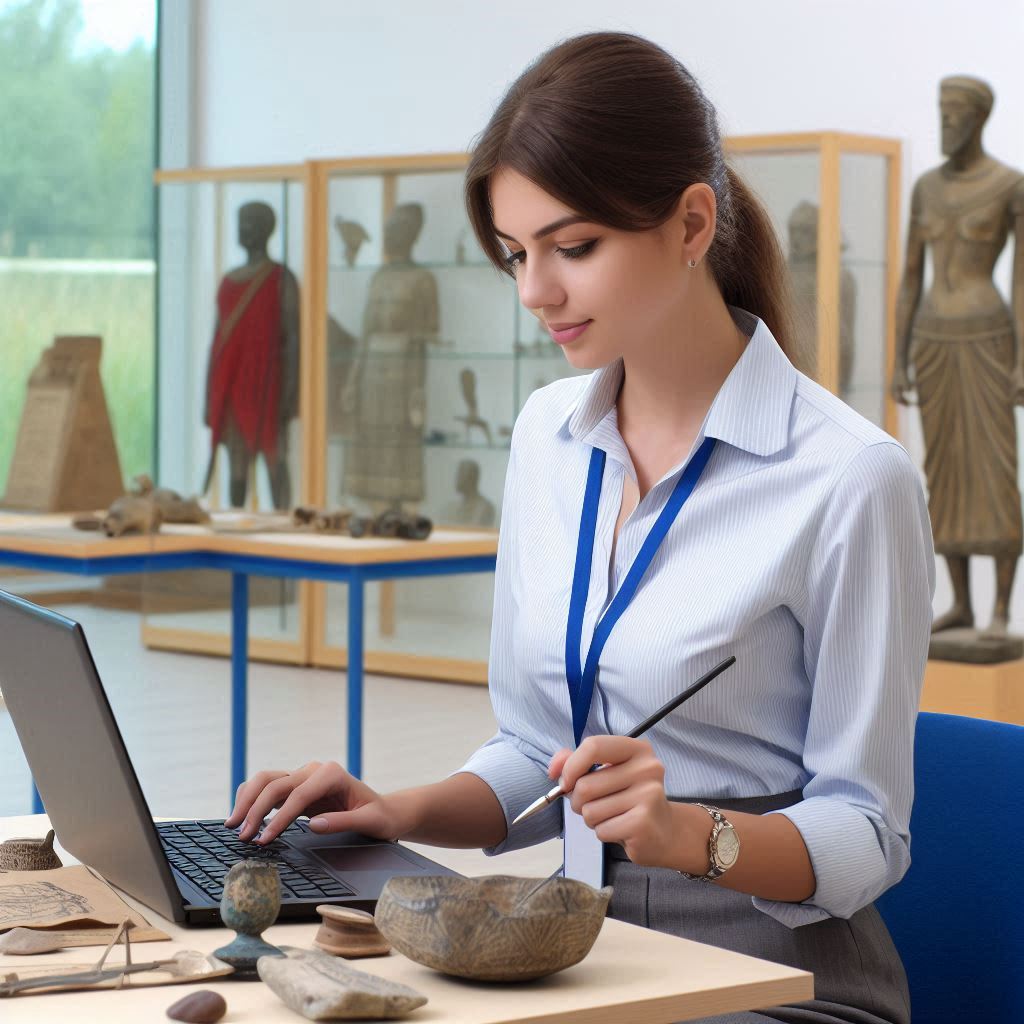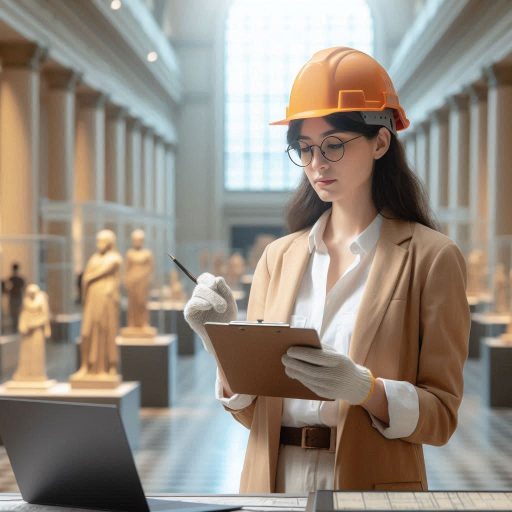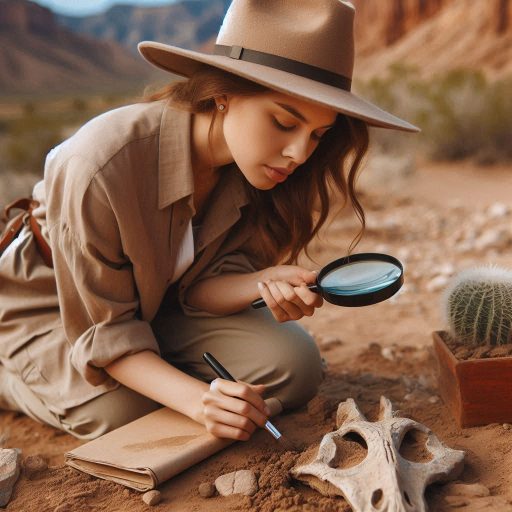Introduction
Archaeology museums in the USA offer a window into our past.
They showcase artifacts that tell stories of ancient civilizations.
These institutions play a crucial role in preserving cultural heritage.
Visiting archaeology museums enriches our understanding of human history and development.
Each museum presents unique collections that span various cultures and time periods.
Visitors can explore exhibits featuring tools, pottery, and artwork from different eras.
Engaging with these artifacts fosters appreciation for the skills and creativity of past societies.
Moreover, archaeology museums often host educational programs and workshops.
These opportunities enhance visitors’ knowledge and provide hands-on experiences.
Such activities inspire curiosity about archaeology and encourage further exploration of the field.
The purpose of this blog post is to highlight notable archaeology museums in the USA.
We will explore their significance, notable exhibits, and visitor information.
By showcasing these institutions, we aim to encourage readers to explore and support archaeology museums.
Visiting these museums deepens our connection to history and nurtures an appreciation for our shared cultural heritage.
Experience the stories behind the artifacts and the people who once created them.
The Field Museum in Chicago, Illinois
History and Significance of the Museum
The Field Museum, established in 1893, is one of the most significant natural history museums in the United States.
It aims to inspire curiosity about life on Earth while showcasing diverse collections.
The museum houses over 40 million specimens, including artifacts that reveal human history and culture.
Highlighted Exhibits Related to Archaeology
One of the museum’s most notable exhibits is “Maya: The Exhibition.”
This exhibit showcases the ancient Maya civilization, featuring intricate artifacts and insights into their daily life.
Visitors can explore Maya hieroglyphs, pottery, and ceremonial items.
This immersive experience deepens understanding of a complex society that thrived in Mesoamerica.
Another highlight is the “Ancient Egypt” exhibit, where visitors can admire an authentic 5,000-year-old Egyptian tomb.
This exhibit presents mummies, jewelry, and tools used in ancient Egyptian burial practices.
The artifacts help illuminate the cultural practices of this fascinating civilization.
The “Inside Ancient Egypt” exhibit also captivates visitors.
It features a detailed reconstruction of a tomb, along with interactive elements that engage guests.
Visitors can learn about ancient Egyptian beliefs, daily life, and the significance of the afterlife.
The Field Museum also offers the “Sue the T. rex” exhibit, showcasing the most complete T. rex skeleton ever discovered.
While not strictly archaeological, this exhibit highlights the museum‘s emphasis on natural history and the context of life on Earth.
Visitor Information and Tips for a Visit
When planning a visit to the Field Museum, consider the following tips.
The museum is located in Grant Park, easily accessible via public transportation.
Parking can be limited, so using public transit is advisable.
Visitors should allocate at least three to four hours to explore the museum fully.
This allows ample time to view exhibits, participate in guided tours, and visit the museum‘s gift shop.
The museum also features several dining options, so guests can enjoy a meal during their visit.
To enhance the experience, consider joining a guided tour.
Knowledgeable staff members provide in-depth insights into exhibits, enriching the overall visit.
Additionally, check the museum’s website for any special exhibits or events during your visit.
The Field Museum offers a rich exploration of archaeology and ancient cultures.
With its diverse exhibits and educational programs, it stands as a must-visit destination for archaeology enthusiasts and curious minds alike.
Smithsonian National Museum of Natural History in Washington, D.C.
Overview of the Museum’s Archaeological Collections
The Smithsonian National Museum of Natural History houses an extensive collection of archaeological artifacts.
It aims to educate visitors about human history and cultural diversity.
The museum features over 145 million specimens, with many significant archaeological finds.
These collections represent various cultures and time periods worldwide.
Visitors can explore exhibits that showcase the evolution of human beings.
The museum emphasizes the interconnectedness of humans and their environments throughout history.
The archaeological collections reflect the rich tapestry of human life, from ancient civilizations to modern cultures.
Famous Artifacts and Discoveries on Display
One of the museum’s most famous artifacts is the Hope Diamond.
This stunning blue diamond weighs 45.52 carats and has a captivating history.
The diamond attracts visitors with its beauty and the legends surrounding it.
Another highlight is the Inca mummy, a remarkably preserved artifact that provides insight into ancient Andean cultures.
This mummy allows visitors to understand Incan burial practices and beliefs about the afterlife.
The “Bones of the Ancient Pacific” exhibit features Polynesian artifacts, showcasing the cultural significance of these islands.
Visitors can admire tools, ceremonial objects, and other artifacts that reveal insights into Pacific Islander life.
Interactive Exhibits and Educational Programs Offered
The National Museum of Natural History offers numerous interactive exhibits.
These engaging experiences help visitors connect with the content on display.
For instance, the “Oceans” exhibit features touch tanks where visitors can interact with marine life.
This hands-on approach enhances understanding of aquatic ecosystems and their importance.
The museum also hosts educational programs for visitors of all ages.
Workshops, lectures, and guided tours encourage deeper exploration of archaeological themes.
Students can participate in field trips that align with school curricula, making learning enjoyable and interactive.
The “Hall of Human Origins” is another significant educational area.
This exhibit uses interactive displays to teach visitors about human evolution.
Multimedia presentations and hands-on activities engage guests and provide a comprehensive understanding of our ancestry.
To maximize your visit, check the museum’s website for current events and programs.
The museum frequently hosts temporary exhibits that feature recent archaeological discoveries.
These exhibitions keep the content fresh and relevant, appealing to repeat visitors.
The Smithsonian National Museum of Natural History serves as a vital resource for understanding human history.
Its archaeological collections, famous artifacts, and interactive programs create an enriching experience for all.
Whether you are an archaeology enthusiast or a curious visitor, the museum offers something for everyone.
Read: How Climate Change Is Impacting Plant Research
The Metropolitan Museum of Art in New York City, New York
Archaeological Treasures Housed in the Museum
The Metropolitan Museum of Art, often called “The Met,” boasts an impressive collection of archaeological treasures.
Its collection spans over 5,000 years of history and includes artifacts from various cultures worldwide.
The museum houses significant pieces from ancient Egypt, Greece, Rome, and the Near East.
One highlight is the Egyptian Art section, featuring mummies, sarcophagi, and exquisite jewelry.
Visitors can explore the Temple of Dendur, an ancient Egyptian temple, reconstructed within the museum.
This remarkable installation showcases the museum’s commitment to preserving and presenting archaeological heritage.
The museum also features Greek and Roman artifacts, including pottery, sculptures, and coins.
These items offer insights into the daily lives, beliefs, and artistry of these ancient civilizations.
The Met’s extensive collection allows visitors to witness the evolution of artistic expression over millennia.
Special Exhibitions and Events Related to Archaeology
The Met frequently hosts special exhibitions focused on archaeological themes.
These temporary exhibits highlight recent discoveries and ongoing research in archaeology.
Past exhibitions have included ancient artifacts and modern interpretations of historical cultures.
For example, an exhibition on ancient Persia featured artifacts like intricate pottery and gold jewelry.
These items illustrated the sophistication and artistic achievements of the Persian Empire.
Special exhibitions provide visitors with an opportunity to engage with archaeological scholarship.
The museum also hosts lectures and panel discussions led by experts in archaeology.
These events foster a deeper understanding of archaeological discoveries and their implications for modern society.
Attendees can learn about recent research, methodologies, and the challenges faced in the field.
Insider Tips for Exploring the Museum’s Archaeological Section
To make the most of your visit to The Met’s archaeological section, plan ahead.
Start by reviewing the museum‘s website for information on current exhibitions.
Check for any special events that might coincide with your visit.
When exploring the museum, consider taking a guided tour.
Knowledgeable guides can provide valuable context and insight into the artifacts on display.
Guided tours often include hidden gems and lesser-known pieces that enrich the experience.
Be sure to allocate ample time for the Egyptian Art section.
This area is particularly popular and can become crowded.
Visiting early in the day or during off-peak hours can enhance your experience.
Utilize the museum’s audio guide, which offers detailed descriptions of key artifacts.
This resource helps visitors appreciate the significance of each piece and its cultural context.
Finally, take breaks in the museum’s designated rest areas.
The Met is vast, and exploring its archaeological treasures can be overwhelming.
Resting ensures you remain energized and engaged throughout your visit.
The Metropolitan Museum of Art provides an extraordinary opportunity to explore the world’s archaeological heritage.
Its treasures, special exhibitions, and engaging events make it a must-visit destination for archaeology enthusiasts.
Whether you are a seasoned expert or a curious newcomer, The Met offers a wealth of knowledge and inspiration.
Read: Exploring the Different Branches of Geology
The Getty Villa in Pacific Palisades, California
Unique Focus on Ancient Mediterranean Civilizations
The Getty Villa in Pacific Palisades showcases the art and culture of ancient Mediterranean civilizations.
This museum specifically focuses on the cultures of ancient Greece, Rome, and Etruria.
Visitors can explore a rich collection of artifacts that span centuries, providing insights into these influential societies.
The museum houses over 44,000 antiquities, making it one of the most comprehensive collections in the United States.
Items on display include pottery, sculptures, and jewelry that highlight the artistic achievements of these ancient cultures.
Each artifact tells a story about daily life, religious practices, and social structures in the ancient world.
The Getty Villa aims to educate visitors about the significance of these civilizations in shaping Western culture.
Through its exhibits, the museum emphasizes the enduring impact of ancient art and philosophy.
This focus makes the Getty Villa a unique destination for anyone interested in Mediterranean history and culture.
Architectural Design and Layout Inspired by Ancient Roman Villas
The architectural design of the Getty Villa is inspired by ancient Roman villas.
The museum’s layout mirrors the classic elements of Roman architecture, including colonnades, gardens, and fountains.
This design creates an immersive experience, transporting visitors to the Mediterranean world of antiquity.
Upon entering the villa, guests encounter a beautiful entrance courtyard filled with lush gardens.
The layout encourages exploration, with pathways leading through various galleries and outdoor spaces.
Each gallery highlights a different aspect of ancient Mediterranean life, from daily activities to religious ceremonies.
The museum‘s architecture also enhances the display of artifacts.
Natural light floods the galleries, illuminating the art and making the experience more engaging.
The attention to detail in the design reflects the beauty of the ancient world.
Workshops and Lectures on Archaeological Topics
The Getty Villa offers a range of workshops and lectures focused on archaeological topics.
These programs aim to deepen visitors’ understanding of ancient civilizations and the methods used in archaeology.
Workshops cover various subjects, such as pottery restoration, ancient cooking techniques, and more.
Lectures often feature prominent scholars and archaeologists who share their research and findings.
These presentations provide insights into current archaeological practices and discoveries.
Attendees can engage in discussions and ask questions, fostering a deeper appreciation for the field.
The museum also organizes family-friendly programs that make archaeology accessible to all ages.
These interactive workshops often include hands-on activities, allowing participants to experience the thrill of discovery.
Engaging with the past through practical activities enhances visitors’ connections to ancient cultures.
Overall, the Getty Villa offers a unique and enriching experience for those interested in ancient Mediterranean civilizations.
Its extensive collections, beautiful architecture, and educational programs create a vibrant learning environment.
Whether exploring the galleries, participating in workshops, or attending lectures, visitors leave with a deeper appreciation for the richness of ancient history.
The Getty Villa stands out as a premier destination for archaeology enthusiasts and anyone curious about the past.
Read: Top Skills Needed for a Successful Geology Career

Penn Museum in Philadelphia, Pennsylvania
Extensive Archaeological Collections Spanning Different Cultures and Time Periods
The Penn Museum, officially known as the University of Pennsylvania Museum of Archaeology and Anthropology, boasts extensive archaeological collections.
Founded in 1887, it houses over one million artifacts from various cultures worldwide.
The museum’s collections represent ancient civilizations from Africa, Asia, the Americas, and the Mediterranean.
Visitors can explore galleries dedicated to Egyptian mummies, ancient Greek pottery, and Native American artifacts.
Each collection provides unique insights into the daily lives, beliefs, and practices of different cultures.
The museum emphasizes the importance of preserving cultural heritage through its diverse exhibits.
The Penn Museum also offers a comprehensive view of human history through its chronological display of artifacts.
Visitors can witness the evolution of societies over thousands of years.
The museum’s extensive collections highlight the interconnectedness of cultures and how they have influenced one another throughout history.
Recent Archaeological Finds Showcased at the Museum
The Penn Museum frequently showcases recent archaeological finds, highlighting ongoing research and discoveries.
These exhibits provide visitors with a glimpse into current archaeological practices and their significance.
The museum collaborates with archaeologists worldwide, bringing cutting-edge findings to Philadelphia.
One notable exhibit is the “Maya 2012: Lords of Time,” which examined the ancient Maya civilization.
This exhibit featured newly uncovered artifacts and insights into the Maya’s complex society.
By displaying recent discoveries, the museum keeps its collections relevant and engaging for visitors.
The museum also hosts temporary exhibitions that focus on contemporary archaeological projects.
These exhibitions often include interactive elements, allowing visitors to engage with the material.
This approach emphasizes the dynamic nature of archaeology and its role in understanding our past.
Archaeology-Themed Events and Programs for Visitors
The Penn Museum offers various archaeology-themed events and programs for visitors of all ages.
These activities aim to enhance understanding and appreciation of archaeology’s role in exploring human history.
Programs include guided tours, hands-on workshops, and family-friendly activities.
One popular program is the “Archaeology Discovery Tour,” where visitors explore exhibits with knowledgeable guides.
This tour provides insights into the artifacts’ historical contexts and the stories they tell.
Participants can engage with the material and ask questions, deepening their connection to the past.
The museum also hosts special lectures and symposiums featuring prominent archaeologists.
These events allow attendees to learn about the latest research and findings in the field.
The Penn Museum prioritizes education and encourages visitors to participate in discussions about archaeology and its relevance.
In addition to these programs, the museum organizes community events that promote cultural exchange.
These events often highlight specific cultures, allowing visitors to experience their traditions and history.
The Penn Museum’s commitment to education and engagement makes it a vital resource for archaeology enthusiasts.
Overall, the Penn Museum stands out as a leading institution for archaeological research and education.
Its extensive collections, focus on recent finds, and engaging programs create a rich experience for visitors.
Transform Your Career Today
Unlock a personalized career strategy that drives real results. Get tailored advice and a roadmap designed just for you.
Start NowRead: The Future of Botany: Emerging Fields and Innovations
Harvard Museum of the Ancient Near East in Cambridge, Massachusetts
Near Eastern Archaeology and Artifacts
The Harvard Museum of the Ancient Near East focuses on the rich archaeological heritage of the Near East.
Established in 1889, this museum showcases artifacts from ancient civilizations like Mesopotamia, Persia, and Anatolia.
Visitors can explore a diverse range of objects, including pottery, jewelry, and inscriptions that reflect the region’s cultural significance.
The museum’s collection offers insights into the daily lives, beliefs, and practices of ancient peoples.
Exhibits highlight significant archaeological discoveries and their historical context.
Artifacts like cuneiform tablets illustrate the development of writing and record-keeping in early societies.
Visitors can also view reconstructions of ancient structures, providing a glimpse into architectural achievements.
The museum emphasizes the interconnectedness of civilizations and their influence on one another.
Through these exhibits, visitors gain a deeper understanding of the ancient Near East’s role in shaping human history.
Collaborations with Archaeological Research Institutions
The Harvard Museum of the Ancient Near East collaborates with various archaeological research institutions.
These partnerships enhance the museum’s research capabilities and expand its collections.
The museum often hosts visiting scholars and researchers who contribute to ongoing projects.
These collaborations enable the museum to present the latest findings in Near Eastern archaeology.
They also provide opportunities for interdisciplinary studies that link archaeology with history, anthropology, and art.
Visitors benefit from these partnerships through enriched exhibits and educational programs.
The museum regularly organizes lectures and symposiums featuring experts in Near Eastern studies.
These events foster discussions about new discoveries and their implications for understanding ancient cultures.
Attendees can engage directly with scholars and gain insights into current research trends.
Virtual Tours and Online Resources for Remote Visitors
Recognizing the need for accessibility, the Harvard Museum of the Ancient Near East offers virtual tours and online resources.
These options allow remote visitors to explore the museum’s collections from anywhere.
Virtual tours provide a guided experience, highlighting key artifacts and their significance.
The museum‘s website features a wealth of educational materials, including articles, videos, and interactive exhibits.
These resources cater to various audiences, from students to lifelong learners.
Visitors can delve into topics related to Near Eastern archaeology at their own pace.
Additionally, the museum engages with its audience through social media platforms.
They share updates on exhibitions, research projects, and events, fostering a community of archaeology enthusiasts.
By leveraging digital technology, the museum expands its reach and enhances public engagement.
The Harvard Museum of the Ancient Near East stands as a premier institution for the study of Near Eastern archaeology.
Its emphasis on historical artifacts, collaborative research, and digital accessibility creates a comprehensive experience for visitors.
Whether visiting in person or online, guests gain valuable insights into the rich cultural heritage of the ancient Near East.
Explore Further: Microbiologist’s Guide to Continuing Education
Gain More Insights: Advancements in Toxicology Testing Methods
See Related Content: Animal Behavior Studies: Insights from Zoologists
Arizona State Museum in Tucson, Arizona
Preserving and Interpreting Arizona’s Archaeological Heritage
The Arizona State Museum plays a vital role in preserving the state‘s archaeological heritage.
Established in 1893, the museum houses extensive collections of artifacts and materials.
These collections represent diverse cultures, including Native American tribes and early settlers.
The museum showcases the rich history of Arizona through exhibitions and educational programs.
Visitors can explore archaeological findings that reveal insights into the lives of ancient peoples.
The museum’s collections include pottery, textiles, and tools that reflect cultural practices.
Through these artifacts, visitors gain a deeper understanding of Arizona‘s past.
The museum emphasizes the importance of protecting archaeological sites and cultural heritage.
They engage the public in discussions about preservation efforts and historical significance.
Hands-On Activities and Educational Programs for All Ages
The Arizona State Museum offers hands-on activities and educational programs for all ages.
Families can participate in interactive workshops that focus on traditional crafts and techniques.
These programs encourage creativity while teaching valuable skills related to archaeology.
Visitors can learn about pottery making, weaving, and ancient technologies through practical experiences.
The museum also provides guided tours and lectures led by knowledgeable staff.
These educational opportunities enhance visitors’ understanding of archaeological methods and findings.
School groups frequently visit to engage in tailored programs that align with educational standards.
The museum strives to make learning accessible and enjoyable for everyone.
Conservation Efforts and Research Projects Conducted by the Museum
The Arizona State Museum is dedicated to conservation efforts and research projects.
The museum conducts archaeological research to uncover Arizona’s hidden histories.
This research often involves collaborations with local communities and Native American tribes.
They work to document and protect significant archaeological sites throughout the state.
Conservation specialists at the museum focus on preserving artifacts for future generations.
They employ advanced techniques to ensure the longevity of delicate materials.
These efforts are crucial for maintaining the integrity of the museum‘s collections.
The museum also organizes public lectures and seminars to share research findings.
These events promote awareness of ongoing archaeological work and its importance.
By engaging the community, the museum fosters a greater appreciation for Arizona’s archaeological heritage.
The Arizona State Museum stands out as a premier institution for understanding and preserving the region’s past.
Through its commitment to education, conservation, and research, the museum serves as a vital resource.
Visitors leave with a deeper appreciation for Arizona’s rich archaeological history and the importance of preserving it for future generations.
Whether through hands-on activities or engaging exhibits, the museum inspires curiosity and respect for the past.
Conclusion
The USA hosts many exceptional archaeology museums worth visiting.
Each museum offers unique insights into the past.
From the Field Museum in Chicago to the Penn Museum in Philadelphia, these institutions showcase fascinating artifacts and exhibits.
The Smithsonian National Museum of Natural History offers extensive collections, while The Getty Villa focuses on ancient Mediterranean cultures.
Visiting these museums provides an opportunity to connect with history.
Each exhibit presents stories of ancient civilizations, enriching our understanding of human development.
Interactive displays and educational programs make the experience even more engaging.
I encourage readers to plan visits to these top archaeology museums.
Exploring these institutions fosters appreciation for archaeology and its contributions to our knowledge of the past.
Supporting museums strengthens their efforts to preserve cultural heritage.
Experiencing archaeological exhibitions in person creates lasting memories.
Visitors can immerse themselves in history, inspiring curiosity and passion for archaeology.
Each museum plays a vital role in educating the public and promoting cultural understanding.
By visiting these museums, you contribute to the ongoing preservation of our shared history.
Embrace the opportunity to learn, explore, and connect with the past through these remarkable institutions.
[E-Books for Sale]
The Big Book of 500 High-Paying Jobs in America: Unlock Your Earning Potential
$19.99 • 500 High-Paying Jobs • 330 pages
Explore 500 high-paying jobs in America and learn how to boost your career, earn more, and achieve success!
See All 500 High-Paying Jobs of this E-Book
1001 Professions Without a Degree: High-Paying American Jobs You Can Start Now
$19.99 • 1001 Professions Without a Degree • 174 pages
Discover 1001 high-paying jobs without a degree! Unlock career tips, skills, and success strategies for just $19.99!




